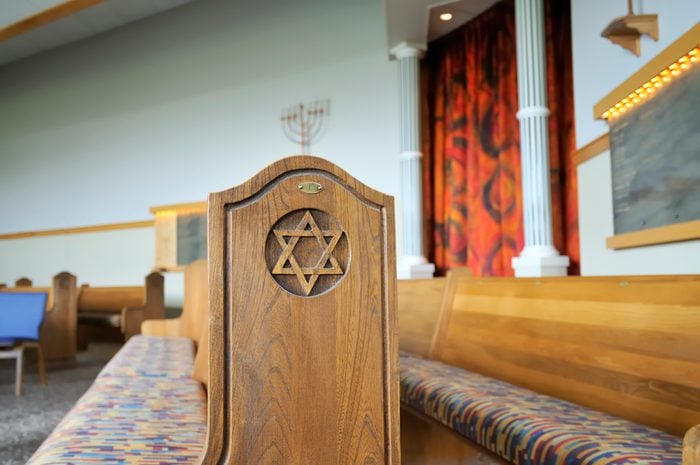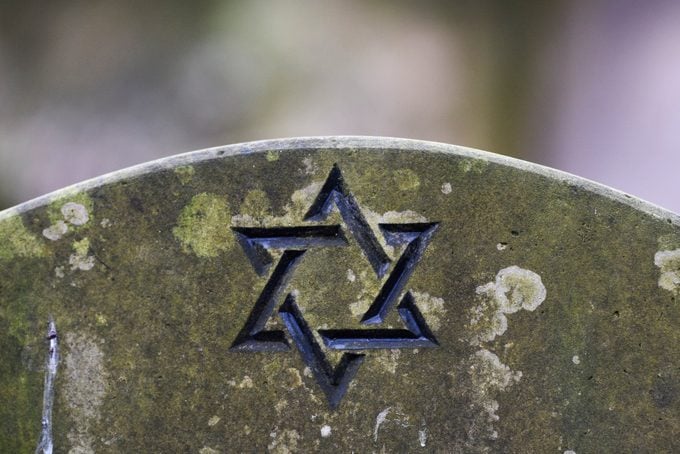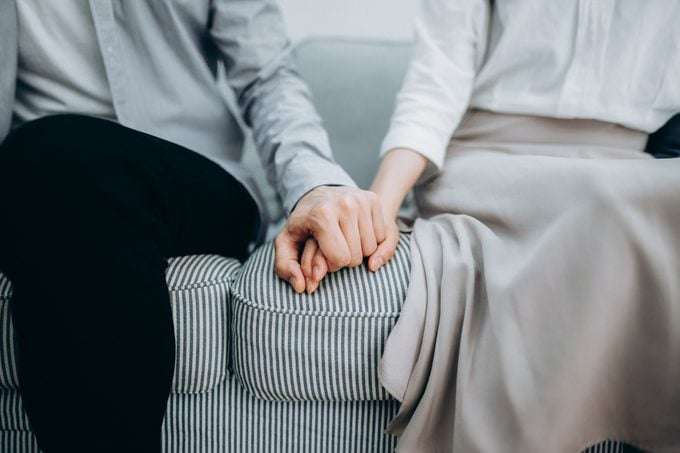Jewish Funeral Etiquette for Non-Jews: An Attendee’s Guide to End-of-Life Events
Updated: Sep. 28, 2023

If you have Jewish friends or loved ones, you’ll probably attend a Jewish funeral at some point. And when paying your respects and being there for your friends or relatives, you want to make sure you’re offering the right kind of support. While Jewish funeral etiquette for non-Jews can seem similar to Christian or other non-secular funerals, there are some important differences, and even basics things like funeral etiquette and condolence messages can vary greatly.
Another thing to keep in mind: Judaism isn’t a one-size-fits-all religion, and not all Jewish funeral services are the same. The three most widely known denominations in North America are Reform Jews, Conservative Jews and Orthodox Jews, and they are progressively more observant when it comes to adhering to the letter of the law. There are also offshoots, such as Moderdox (Modern Orthodox) and Conservadox (a Conservative-Orthodox blend), not to mention Hassidic Jews.
I’ve long been fascinated by the differences in various faiths, including my own. I grew up in a progressive Orthodox family, though almost all my extended family is made up of Hassidic Jews. At one point, I wanted to become a rabbi, and while that didn’t turn out to be the right path for me, today I am a chaplain. That’s all to say that I’ve studied this quite a bit, and I often explain the Jewish faith to dear friends and colleagues from a wide array of backgrounds. In answering their questions, I started realizing just how nuanced some of the differences are when it comes to faith-based etiquette, which is why you might find these funeral and shiva guidelines helpful.
Get Reader’s Digest’s Read Up newsletter for more etiquette tips, humor, cleaning, travel, tech and fun facts all week long.
What to expect at a Jewish funeral
The first thing you should know is that Jewish funerals happen quickly. In Christianity, funerals usually take place about a week after the death. In Judaism, however, it is considered the ultimate act of kindness to bury someone Jewish within 24 hours of their passing, when possible. Here’s what will happen at the services.
Prayers and eulogies
The service at a Jewish funeral will often take place at a chapel and usually involve prayers, psalms and eulogies (known as hesped). Family members, colleagues or rabbis may deliver the eulogies. The male mourner recites the Mourner’s Kaddish, and the congregation says amen. At the grave site, it’s customary for only the closest family members to attend, along with a minyan (a quorum of 10 adult Jewish males) in Orthodox services.
A small gathering
Jewish funerals can be on the small side. Unless the deceased was a celebrity or widely known throughout their community, more often than not, a Jewish funeral won’t be a who’s who of mourners. In fact, “only family members and those closest to the deceased come to Jewish funerals,” says Phil Katz, an end-of-life doula and former professor of world religions. If you’re invited to attend the funeral, it’s likely the family or the deceased felt close to you and wanted you there with them.
A simple coffin
Plain pine coffins are almost universally used in Jewish burials. Also worth noting: There’s no fancy outfit for the deceased, though you likely wouldn’t see this anyway, since there are no open-casket services in the Jewish faith. But the deceased will likely be clad in tachrichim, or simple white linen shrouds. According to Katz, this level of simplicity began with the ancient Jewish sages, who didn’t want mourners or the poor to feel pressured to buy expensive coffins or clothing for the dead. “In this way, it’s all egalitarian in the end,” Katz explains.
Asking forgiveness
You may see family members near the coffin seemingly whispering or talking to the deceased. And, in fact, that’s what they are doing—specifically, asking forgiveness, explains Chaplain Rabbi Mendy Coën, Director-General of the United States Chaplain Corps. This is also a way to “untie bad connections,” allowing people to move on and mourn, adds Coën. For those with lingering guilt or unresolved issues, it presents a way to ask the deceased for forgiveness one final time.
No flowers
In keeping with the ideals of simplicity and modesty, Jewish funeral etiquette dictates that there shouldn’t be lavish floral displays anywhere. “Jews don’t do flowers at funerals,” Coën says. While gifts of food are welcome at the shiva, try to wait until then to send anything. (More on that below.)
The Mourner’s Kaddish
One universal element at all Jewish funerals is the recitation of the Kaddish prayer, also known as the Mourner’s Kaddish. It takes place at the end of the service, and you might sense it’s coming when a male relative comes to the dais and begins to pray. According to Coën, the Kaddish prayer offers two levels of comfort: “The beginning of Kaddish is almost a spiritual prayer for the soul to be comforted. The second round of the prayer is for those left behind.”
Worth noting: The Kaddish prayer is about 2,000 years old, and it is recited in the ancient language of Aramaic. While it is said at the funeral and again at the burial, those are not the only times. Depending on the level of observance, the male son of the deceased may also recite the Kaddish prayer three times a day for 11 months.
Kriah: Rending of the mourner’s garment
One tradition that might be surprising to non-Jewish attendees at a Jewish funeral is kriah (pronounced kree-ah), the Hebrew word for tearing—or tearing of the garments. Those closest to the deceased will have the lapel of a jacket or part of their shirt cut; that piece of material will then be refastened to the garment with a safety pin. The tradition goes back to biblical times, when rending one’s garments was a tangible and visible symbol of grief. Some Jews don’t actually tear their clothing but instead may pin on a black ribbon or wear an armband to symbolize their state of mourning.
When my father died, I wore a shirt he loved to his funeral, and as is tradition, I wore the same clothing for the entire shiva period. My father loved fashion. For me, cutting that shirt with its beautiful bright pink and turquoise roses, and then patching them together with a safety pin, symbolized the way that my grief over losing him superseded everything else in my life.
What to do during a Jewish funeral service
Some people believe that you should not address the family during the service and burial, and that’s actually the most respectful approach. During a Jewish funeral service, the family sticks closely together. While there might be a short time before the service begins to pay your respects to the family and the deceased, try not to impose in any way. Depending on how close you are to the family or how close you were to the deceased, you’ll know if a nod will suffice or if a few words are more appropriate. If you recognize co-workers or colleagues (who are not part of the family), you can sit with them. And if you don’t know anyone personally, sit at a respectful distance from the family and immediate mourners.
There may be one or more eulogies given by multiple people during a Jewish funeral. In more Orthodox or Hassidic circles, it’s unlikely that you’ll hear women giving the eulogy. And depending on the group, you may hear only psalms recited; Coën says this is traditional in the Chabad observance. (Chabad, also known as Lubavitch, is a specific Orthodox Jewish movement.)
Some congregations will speak in Hebrew or Yiddish and may or may not provide English translation. When in doubt, simply say amen when the rest of the attendees do. But keep an ear out: In English, it’s pronounced as “ay-men,” but the Hebrew or Yiddish pronunciation could sound more like “uh-mayn.”
What to do during a Jewish burial

As for the burial itself, unless you’re a close member of the family, it’s unlikely you’ll be expected to join. Before the interment, there will be brief prayers and psalms, and likely another reciting of the Mourner’s Kaddish. Again, if you do attend, keep a respectful distance from the family and solemnly pay your respects.
One last thing: It’s unlikely that you’ll ever attend a Jewish funeral service with a cremation. The majority of Jewish observances share the belief that cremation is prohibited. There are many reasons for this, including the idea that the body should not be defiled after death, that cremation is a pagan-inspired practice, and that the soul remains tied to the body after death and so burial allows for a more gradual parting. There’s also the lingering pain of the Holocaust, when 6 million Jews were murdered and then cremated in the ovens at the Nazi concentration camps.
What is a shiva?
A shiva refers to the seven-day mourning period that follows the funeral for immediate family members of the deceased. The expression is “sitting shiva,” since the mourners quite literally sit around and don’t leave the home for seven full days. During the shiva (the Hebrew word for the number seven), friends, relatives or neighbors may visit to console the mourners. The times that are appropriate to visit will often be posted on the door to their home or in local publications.
“A shiva is, in theory, similar to a wake,” Katz says, “though a wake happens before the burial and a shiva takes place afterward.” To put it into perspective, “while Jews don’t have wakes and don’t display the body beforehand, the shiva is almost like a wake without a body.”
How to pay your respects
Traditionally, only the closest family members will visit on the first three days of the shiva, though in some Reform families, shiva is only observed for a total of three days. According to tradition, the one who is in mourning should be the first to speak. Today, the majority of families don’t really keep to that tradition, but some might. It also makes things less awkward if you’re not great at conversation, at least in theory, since the person doing the mourning should be the first to speak. If you’re not sure if you should say hi or not, try taking a seat and seeing if there’s already a conversation going on. That’s a comfortable ice-breaker while you figure out how to pay your respects.
What to expect
You might notice the mourners sitting on low chairs, and not wearing makeup or jewelry. At most shivas, mirrors are also covered to symbolize the mourners’ lack of vanity during this time.
You may also notice signs on the wall with the traditional sayings or blessings you can make at a shiva, such as: Hamakom yenakhem etekhem betokh shaar avelay Tziyon ViYerushalayim. Loosely translated it means: May God comfort you amongst the rest of the mourners of Zion and Jerusalem. Other common sayings are: May we only meet at simchot (celebrations), and May you not know any more tza’ar (suffering or pain).
But don’t worry: If you’re a non-Jew at a shiva, you’re not expected to say or do anything specific. Jewish funeral and mourning etiquette for non-Jews is very forgiving. You can read up on some other Jewish traditions and observances in this article I wrote about Jewish American Heritage Month.
What to bring to a shiva
As mentioned above, flowers aren’t an appropriate gift for a Jewish funeral or shiva, and this is an important bit of Jewish funeral etiquette that non-Jews should know. If you can’t attend the funeral but want to send something to the family, consider a gift of fruit, nuts or something else edible. While it’s always a nice idea to bring something with you to a shiva, there really are no rules as to what it should be.
You might find there’s a list of people who are preparing meals for the family, so sending over a full meal from a restaurant on the approved list is also helpful. Cookies are always a great option, and if you’re not attending in person, feel free to send a sympathy gift basket from an online site. You can also be thoughtful with the food gift. If you always shared KitKats with the deceased at work, bringing some to the shiva and sharing the origin story will likely bring great comfort to the family. One important note: Depending on their level of observance, check that the gift you send is kosher.
Friends and relatives of the mourners may also set up a meal-delivery system. Even if you’re tempted to cook or bake something, you might want to hold off, since some very observant people might not eat food baked in a non-kosher kitchen or made without strictly kosher ingredients. Instead, perhaps, consider chipping in for one of the meals.
What to wear to a Jewish funeral and shiva

Queen Victoria, who lost her husband in 1861, really set the scene for how to think of mourning clothes today, with specific rules for what to wear and what not to wear. This, however, was less of a thing in Jewish circles, and you’ll still see that reflected in today’s Jewish funeral etiquette.
Black isn’t required
“At non-Jewish funerals, black is what you wear traditionally,” Katz says. “At Jewish funerals, you might see black at less religious ceremonies. At more Orthodox funerals, you’ll see people come as they are—you might even see a denim skirt.” At a Hassidic funeral, women might be expected to cover up more in general. At observant funerals, you might see women donning head scarves in the chapel (even if they already cover their hair after marriage). But if you’re not Jewish, none of this is expected of you.
That said, Jewish funeral etiquette for non-Jews and Jews dictates that “women should dress modestly, depending on how Orthodox the crowd is,” says Katz. Your best bet is to follow what the others are doing, and use common sense. “If you’re going to a graveside service in the summer,” he notes, “don’t wear shorts.” In general, you might want to wear muted colors or patterns, simply to blend in. As at most funerals, bright colors or loud patterns might seem out of place. If in doubt, opt for business casual.
Dress appropriately at the shiva too
At a shiva, you should also err on the side of modesty. While that means different things to different people, something toned down will generally be your best bet. A few other handy guidelines: Bare arms might be perfectly appropriate at a Reform shiva, but less so at an Orthodox one. Leggings might be a bit too casual, unless you pair them with a tunic-style top. And don’t worry about looking “dressed” for the occasion: For men, a suit would be a bit too much, so opt for a button-down shirt and a nice pair of pants, or even jeans.
A yarmulke is usually a good idea
You may have seen small circular skullcaps or similar head coverings called yarmulkes (also known as kippah, the Hebrew word for “dome”) on observant Jewish men. It symbolizes that the wearer is aware of the higher power above them.
So, should non-Jews wear one at a funeral service? “Generally, in Jewish places, even non-Jewish men should put on a yarmulke,” Katz says, but there’s no requirement to do so. “You can’t go wrong putting one on, though in classic Reform Judaism, even Jewish men don’t wear a yarmulke.”
How to offer condolences
“The best way to offer condolences is face-to-face,” Coën says. “But you don’t have to do it in person. You can also do it by phone or tell a friend who will be at the shiva to send your condolences. If you can’t get to the shiva in person, sending a card or even an email is acceptable.
There’s no real Jewish funeral etiquette for non-Jews regarding how to send a condolence note or greeting. But if you do send a card, try to be sensitive to the fact that many condolence cards actually have New Testament quotes or greetings, which would be inappropriate to send to a Jewish person in mourning. You might find some inspiration from these funeral poems. Or, one of the easiest things to say is: “May her/his memory be a blessing.” It’s a classic response to hearing that someone has passed, or a respectful way to say they’ll be remembered positively.
Looking for other things to say? A few basic phrases that will always work are:
- Please accept my sincere condolences.
- They’ll be missed.
- We’re here for you and your family. (And then follow up with a specific way you might be able to help.)
And don’t feel limited to sending a card or gift of food either. If you and the person in mourning are close enough to text, you can send a message or call them. It’s OK if they don’t get it until after they’ve “gotten up” from sitting shiva. That said, in these more tech-connected times, mourners will usually have their cellphones with them throughout the shiva, so you can call, text or FaceTime at any point to express your sympathy.
About the experts
- Phil Katz is an end-of-life doula and former professor of world religions.
- Chaplain Rabbi Mendy Coën is the Director-General of the United States Chaplain Corps.
Sources:
- Chabad.org: “Selected Psalms to Be Recited in the Presence of the Deceased”
- LastKindness.org: “Cremation or Burial: A Jewish View”



